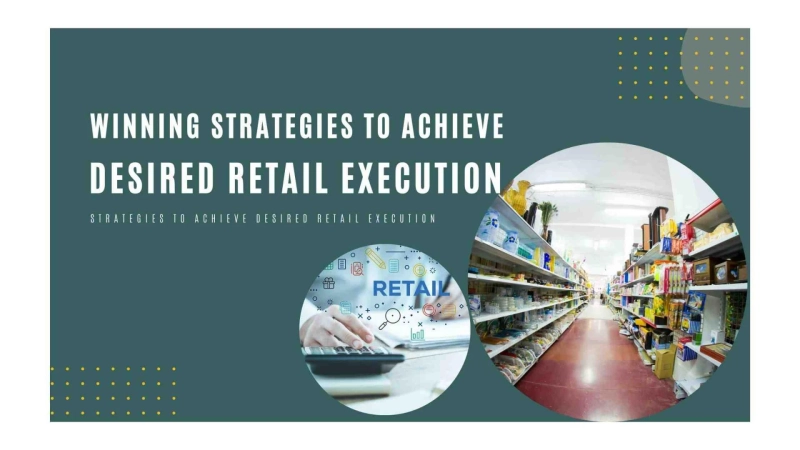Retail execution is a strategy that many CPG companies use to control and supervise how their products are exhibited in stores. This strategy is often focused on key performance indicators (KPIs), such as price, presence, and promotion. A collection of industry knowledge regarding the subtle ways in which CPGs may draw customers to the shelf, improve sales, and win market share has been developed over decades of data and study. However, during the past 15 years, the competition has been more intense as practically every major consumer products company has developed its own in-store execution strategies using Retail Execution Field Tools.
The best CPGs are able to acquire a comprehensive perspective of their retail performance in shops by measuring a variety of KPIs for retail execution in a systematic fashion, such as product presence, promo, share of shelf, and so on. These insights are priceless as the producers can see what kind of errors are being made and where they are occurring. These insights become useful when data is analysed and given in a timely manner, allowing firms to deploy resources where they are most required and make execution changes as quickly as feasible.
Importance of execution strategies
The rise of SaaS has encouraged businesses all over the world to create these types of solutions that offer quick, practical insights and open the door for evaluating and putting new execution techniques into practice. In turn, these tactics enhance brand recognition and increase sales. Because of the quick changes in the retail industry, technology must be included into routine tasks. This highlights the need of utilising retail execution solutions to the fullest extent possible.
Simply implementing solutions is insufficient because some brands are adopting technological approaches for optimising their ideal store, and they are succeeding by giving field representatives access to data and tools to engage store managers with useful information, guiding sales representatives with the steps and best practises to achieve their store targets, and providing technology and tools to streamline and simplify retail execution.
Retail execution and monitoring strategies
Creating a retail execution and monitoring strategy requires first knowing what data sources and technologies are available. The variety of choices, from internal field teams to the crowd, Sales Force Automation technologies to Image Recognition, has never been bigger. The strengths of various technology and data source combinations vary, therefore the choice is greatly determined by the profile, objectives, and resources of the firm.
One of the most crucial things to take into account when utilising a different data source or technology is the ROI. For decision-makers, the price and dependability of cutting-edge technology, like IR, were crucial. However, these worries go beyond a desire to see technology costs cut: technologies like ‘IR’ may be considered a value-add when calculated in terms of the time saved for staff during store visits.
Strategies to achieve desired retail execution
Image Recognition for retail execution
Prior to the technology revolution, merchandising managers had to rely on field representatives to acquire data from stores. Due to biases in the authors\' own judgments and a lack of clear directions, this material was frequently erroneous. But if managers have access to shelf photos that provide them a clear understanding of what\'s occurring on the shelves, this gap may be closed. The use of picture recognition makes this feasible.
Advanced image recognition technology can automatically identify competition strategy at the store level as well as Key Performance Indicators (KPIs) including out-of-stock, vacant spots, share of shelf, share of visible inventory, and planogram compliance. With the use of machine learning, image recognition can scan even the tiniest elements on a shelf and analyse them using compliance measures and KPIs that have been predefined.
Sales Reps Management
One of the most important elements in the retail execution process is data collecting. Field representatives are essential to gathering data. Because of this, this functionality is essential and ought to be included in any efficient retail execution solution. It assists CPGs in assigning shops, maximising routes, and tracking the activities of their field reps. The manufacturer can identify the following store that requires attention and design a corrective course to increase sales using Point of Sale (POS) data. The representatives can create a strategy and determine the most crucial activities to complete in the shop by reviewing POS data before they arrive at the location.
Data Visualisation
The senior management, sales representatives, and in-store workers all need to understand the value of data visualisation. Business and retail intelligence must be a component of any retail execution tool. In order to adjust the company plans as needed, it should be able to develop and assess KPIs and analyse patterns.
The most effective technique to assess individual or group performance in the retail sector is using analytics dashboards. It can provide information on sales, merchandising, promotions, and the shopping experience. Your firm will develop if you include an advanced analytics dashboard into your retail execution system.
Leave no SKU behind
Maintaining brand health requires a lot of time and work since there are thousands of items spread over an ever-growing shop universe. It is impossible to gather information about shelf presence or make sure things are in the appropriate place on a large scale using conventional techniques.
However, automatic image recognition programmes like ShelfWatch are capable of correctly identifying and analysing each SKU in every shop. A multinational FMCG producer saw up to a 20% difference when evaluating share of shelf using image recognition as opposed to manual approaches, according to a research. When it comes to planning for the ideal retail implementation, this increase is crucial.
Mapping Integration
The decision-maker can pinpoint specific stores that need upgrading by using GeoTagging and mapping tools to aid this process. After that, they may discuss the plans and take the appropriate steps. Automated GeoTagging can also assist sales representatives in finding and locating the shop closest to them, which will speed up the data gathering process.



